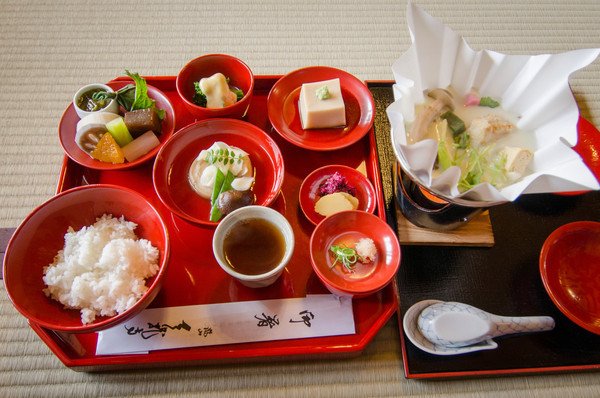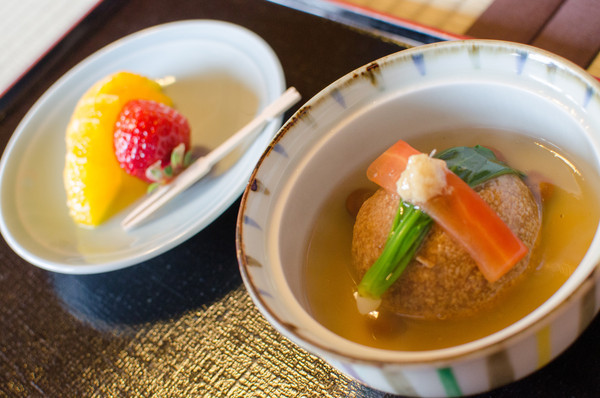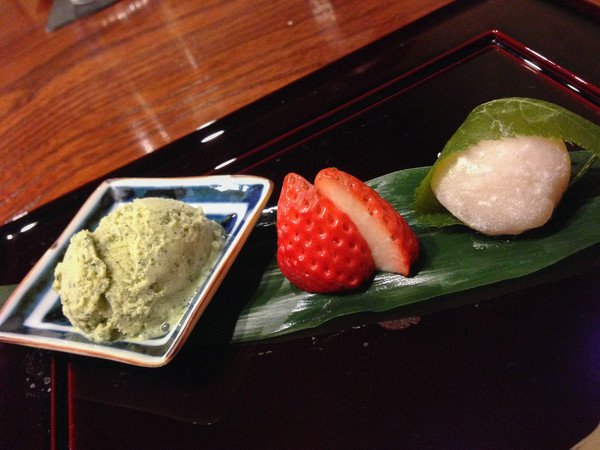
Though I spend a lot of time thinking about the things I eat, I was still blown away by how much thought goes into the preparation, consumption, and appreciation of Japanese food. There is a level of obsession with food in Japan that I’ve never seen anywhere else.
If you love to eat and enjoy exploring food, culture, and culinary traditions, Japan should be at the top of your world travel bucket list.
Here are some things you should know about Japanese food:
- Japanese cuisine is one of only three national food traditions recognized by the UN for its cultural significance
Last December, UNESCO, the United Nation’s cultural organization, added traditional Japanese cuisine, or washoku, into its Intangible Cultural Heritage list meaning that the preservation of this way of eating is vital to the survival of the traditional culture. It was only the second national traditional cuisine honored as such, after French food. (Mexican cuisine has recently joined the list.)

- Japanese food is prepared carefully using seasonal ingredients and flavors
Japanese food is as much about the preparation and presentation as it is the food itself. A great deal of thought goes into every item served. While we think of only four annual seasons, Japanese chefs consider dozens of seasons and carefully select ingredients that are in their prime with flavors that represent that specific period. Because we visited in the very early spring (beginning of March) every meal that we tried included bitter components which is a typical flavor for this season. Tasting these flavors, connects Japanese eaters with years past.
Once finished, the food is carefully plated and the finished dish often looks like a work of art.

- Simplicity is key
Courses include a few small items, often fresh and with simple flavors. Japanese chefs work with top quality ingredients and do as little to the food as possible to bring out the color and flavor.

- Infrequent use of garlic, chile peppers, and oil
Many foods are seared, boiled or eaten raw and minimally seasoned. Umami (a rich flavor profile characteristic of Japanese food) is enhanced by using just a few ingredients including miso, soy sauce, mushrooms, seaweed, bonito flakes, and bonito broth. When foods are fried (like tempura) the batter is thin and absorbs very little oil.

- Condiments add diversity
To add contrast to the food, simple condiments are often added to enhance the flavors. Light dipping sauces, citrus, miso, wasabi, pickles, and soy sauce may be included with the course.

- It doesn’t look like a lot of food but it is!
Though the individual servings are small, traditional Japanese meals (called kaiseki) include several courses which add up to a lot of food. You will fill up.

- The choice of dishes is important
While Western cultures tend to appreciate matching dishware, Japanese cooks tend to use dishes with a variety of colorful patterns, shapes and colors. The specific choice of dishes is important and seasonal. Fine restaurants will often use antique ceramics and lacquerware. When your server brings you a course, after asking what the food is, it is expected that you will also ask them to tell you about the dishes. The hand-painted bowl below (from a restaurant in Kyoto) was over 200 years old! It was selected because the leafy pattern represents the early spring season during which we visited, and it also provides a contrast between the old and the new green shoots of spring.

- Tokyo has some of the best restaurants in the world
With 14 Michelin three-star restaurants, Tokyo has more top-rated restaurants than any other city, surpassing even Paris.

- The seafood industry is HUGE!
As seafood is a major part of the Japanese diet, the seafood fishing and import industry in Japan is staggering. Tsukiji Market in Tokyo is the world’s largest wholesale markets for fresh, frozen, and processed seafood and sells over 700,000 tons of seafood each year. In this photo below, this massive market complex takes up all of the low-rise buildings in the foreground (lower 2/3 of the photo). And this is just one of 12 wholesale fish markets in Tokyo alone!

- Japanese meals include a lot of vegetables but finding completely vegetarian food is hard
Japanese cuisine has a much higher ratio of plant-based foods than is typical in the U.S., but it is still hard to eat completely vegetarian. This is because many traditional dishes are cooked in fish broth or are sprinkled with bonito flakes. I’m vegetarian, and though we did our best to find plant-based alternatives within the traditional menus, there were a few times when I ate things that were not strictly vegetarian because they were cooked in fish broth, or which I had to scrape off the bonito flakes. That was fine with me, I was willing to do that in order to experience traditional food culture. Travelers that avoid seafood for religious reasons or because of allergies will find it a bit harder to stick to their diet.

- Japanese people love beautifully crafted and gift-wrapped sweets
Every region of Japan has different styles of typical traditional sweets, known as wagashi. These delicate creations are often sold in beautifully wrapped boxes, in convenience stores and in train stations because they are customarily given as gifts to friends and family. One of my favorite sweets was Kyoto’s yatsuhashi (shown below), thin, triangle-shaped sweet rice wrappers filled with red bean paste.
Just whatever you do, don’t eat the sweets on the sidewalk or while standing or walking anywhere in public. Eating anything, anywhere outside of restaurants and food-serving establishments is considered rude! And that brings me to…

- Japan’s many food rules and food etiquette
There are lots of rules for proper etiquette that apply to every aspect of life in Japan, including food. Some of these I had heard before we arrived, like it is polite to make a slurping sound when eating noodle soups, though, you should not slurp if you are eating soup made with rice. Sticking your chopsticks straight up in a bowl of rice is very rude, as is (to a lesser extent) laying your chopsticks across the bowl you are eating from. Always use the chopstick stand (if provided), and if not, fold the paper chopstick wrapper into a tent shape and rest the tips of the chopsticks on that. More rules on Japanese etiquette will be covered in a future post.

- It’s rude to leave a messy plate
Another etiquette rule that surprised me is that you’re not supposed to leave your plates covered with a pile of crumpled up napkins and garbage. Our guide told us that shows a lack of respect for the restaurant staff and the meal they served. She suggested we fold (or even tie a bow!) in our used napkins.

Hi! I am a robot. I just upvoted you! I found similar content that readers might be interested in:
http://www.everintransit.com/japanese-food/
Downvoting a post can decrease pending rewards and make it less visible. Common reasons:
Submit
wow, I like to eat teste food
Downvoting a post can decrease pending rewards and make it less visible. Common reasons:
Submit